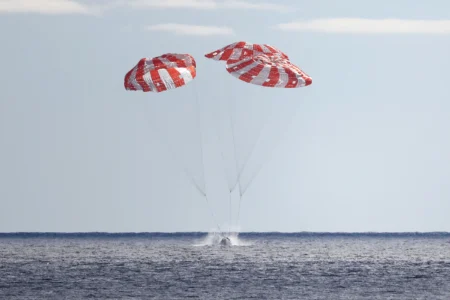
NASA’s Orion spacecraft has returned to Earth. The uncrewed capsule landed safely in the Pacific Ocean off Baja California, Mexico around 12:40 p.m. ET (7:40 p.m. Kyiv time) on Sunday. This marked the successful end of the Artemis I lunar mission.
During the final phase of the mission, during the return to Earth, the capsule reached a speed of 24,500 miles per hour (39,429 km/h), and its heat shield could withstand temperatures of about 5,000 degrees Fahrenheit (about 2,760 Celsius). In total, the Orion capsule traveled about 1.4 million miles (about 2.25 million km) during the 25.5-day mission.
After several delays, NASA’s Space Launch System (SLS) rocket launched on November 16 and sent the Orion capsule on a mission around the Moon. The capsule passed within 130 km of the surface of the Moon before moving away at a distance of 91,700 km from the Moon, where it entered a high orbit. About midway through the mission, the spacecraft reached a distance of 268,563 miles (432,210 km) from Earth, the longest distance traveled by any manned spacecraft.
Splashdown.
After spending 1.4 million million through space, an orbiting title, and collecting time that will make you two astronauts on future #Artemis missions, @NASA_Orion spacecraft is home. pic.twitter.com/ORxCtGa9v7
— NASA (@NASA) December 11, 2022
Course
WOMEN IN LEADERSHIP
Learn how to maintain work-life balance from a top executive with experience at NPR, Microsoft, IBM, and Amazon Alexa.
REGISTER!
When entering the earth’s atmosphere, the capsule performed an “entry pass” maneuver. It first plunged into the upper layers of the atmosphere, then rose, after which it finally entered the atmosphere. This helped the device to land in the given area. For the first time, a spacecraft intended for the transportation of people performed such a maneuver. After reaching an altitude of about 24,000 feet (about 7,300 meters), the capsule began deploying its parachutes to slow down before splashing down.
NASA will now begin collecting data from sensor-equipped dummies aboard the capsule to prepare for future manned missions. The second NASA Artemis mission is scheduled for 2024. It involves sending astronauts on a trip around the moon. Eventually, NASA plans to return humans to the surface of the moon as part of the Artemis III mission, but that may not happen until 2026.
NASA selects SpaceX Starship for another crewed landing on the moon under the Artemis program — expected no earlier than 2027
Source: The Verge




